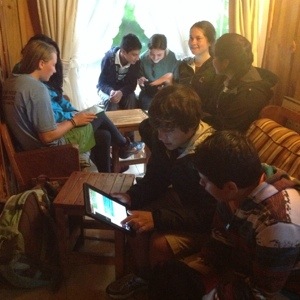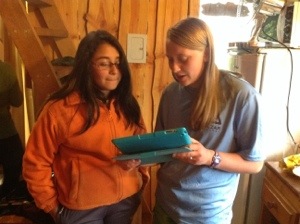Let them play soccer. Let them speak Spanish. Let them eat cake.
Choshuenco is a small sleepy pueblo (town) nestled in the feet of the Andes mountains. For years the Alzar School has brought students to Choshuenco, not simply for its electric blue braided rivers and towering white volcanoes, but for its open-hearted people. This semester, English class took on the interdisciplinary challenge of connecting our students with town locals through a project called “Faces of Choshuenco.” Guided by our teaching fellow Molly Rodgers, students worked in pairs interviewing Choshuencans, translating transcripts, and creating biographical photo-journals of these people’s lives, as well as autobiographical photo-journals to share. They then planned an inter-cultural event to bring our communities together for an afternoon of soccer, BBQ and story sharing. With Molly’s guidance, students planned, shopped, and cooked the meal, wrote invitations to their interviewees, and made a rainy day plan B.
Yesterday, the event proved a success. While Plan B turned to Plan C when the relentless rain drove us inside the local school gymnasium, Alzar School students were quick to adapt (as always). In moments we found ourselves in the thick of a 8-vs-8 Gringo vs. Chilean indoor soccer game. Ages ranged from 8 to 16. Seasoned soccer players and shy novices. Spanish and English. Laughter was, once again, the universal language that filled the gymnasium, spilling into the school halls outside, drawing more and more students, curious parents and teachers. I watched as our more timid Spanish speakers had the opportunity to shine on the court, and our newer soccer athletes pushed themselves to make a pass, or charge a fleet-footed fifth grader. The game ended with sweaty high fives and hugs across cultures. We decided to invite them to the rest of the event.

While unfortunately the interviewees were unable to attend due to previous obligations – a police man on watch, a librarian teaching evening driving classes, a store owner needed behind the counter – our new fútbol friends quickly filled the gap. Ditching our raincoats at the door, our cabañas were brimming with bilingual conversations and shy smiles. We laughed together as the Chileans explained that the typical “North American” cuisine students had prepared (hot dogs) was more popular in Chile (“completos”). With mouths full of cake, students traded “favorite foods and sweets” facts and “what I like to do in my free time.” After initial awkwardness, we decided to share our mini-photo-journals with our new friends. Perfectly paired one-to-one, Gringos shared their autobiographies on their iPads. Intro Spanish students took turns reading their original Childrens’ Books to the youngins that had wandered in.
All of a sudden, the room was overfull with conversation. Fluid, genuine conversation. Teenagers learning about each other, asking each other questions, laughing at all the little misunderstandings and clarifying until they could nod with satisfaction.
Students wrote down names to continue their friendship as techno-age pen-pals (Facebook), and a local mother asked to adopt a sweet gringo. An Alzar School student approached me with a victory smile – “That was the most Spanish I have consecutively spoken in my life!” And another chimed in – “I can’t believe it! I understood almost everything Marisol said!” Molly, Dawn and I took a moment to smile.
These are the opportunities that impact youth. These are the moments students remember. This is the reason we travel.




